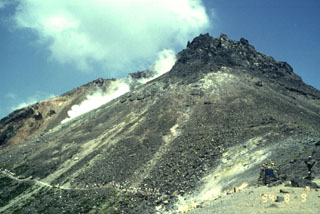Report on Nasudake (Japan) — October 1985
Scientific Event Alert Network Bulletin, vol. 10, no. 10 (October 1985)
Managing Editor: Lindsay McClelland.
Nasudake (Japan) Two earthquake swarms
Please cite this report as:
Global Volcanism Program, 1985. Report on Nasudake (Japan) (McClelland, L., ed.). Scientific Event Alert Network Bulletin, 10:10. Smithsonian Institution. https://doi.org/10.5479/si.GVP.SEAN198510-283150
Nasudake
Japan
37.125°N, 139.963°E; summit elev. 1915 m
All times are local (unless otherwise noted)
Local seismic activity increased 9-12 September at the N foot, about 10 km from the summit. Magnitude [3.5] events recorded on 9 and 11 September were felt at intensity I and II at a town 7 km NW of the summit, but were not felt at the JMA Nasudake Volcano Observatory, about 19 km to the SSE.
Another swarm of small earthquakes occurred [27-29 September] at the NE foot, about 10 km from the summit. Three larger events were felt at Kashi hot spring, 7 km NE of the summit, but again none were felt at the JMA Observatory. The JMA seismic network in this area could not accurately determine hypocenters and magnitudes of small events. The largest events of this swarm were estimated to be roughly magnitude 2.7. Earthquake swarms are common around Nasu.
Geological Summary. The Nasudake volcanic group consists of a N-S-trending cluster of stratovolcanoes and lava domes at the north end of the Kanto Plain. Volcanic activity dates back about 500,000 years. Growth of three large basaltic-to-dacitic stratovolcanoes, each lasting about 200,000 years, was followed by construction of three smaller andesitic stratovolcanoes, Asahidake, Futamatayama, and Chausudake. Activity during the last 55,000 years included the collapse of Asahidake volcano about 30-40,000 years ago, producing the massive Ofujisan debris-avalanche deposit, which covers a broad area SE of the volcano. The youngest volcano, Chausudake, began forming about 16,000 years ago. Six magmatic eruptions took place since then, the latest in 1408-1410 CE, when the Chausudake summit lava dome formed. These eruptions produced block-and-ash flows and concluded with the extrusion of lava flows. Smaller phreatic eruptions have occurred every few hundred years during the past 5,000 years.
Information Contacts: JMA, Tokyo.

